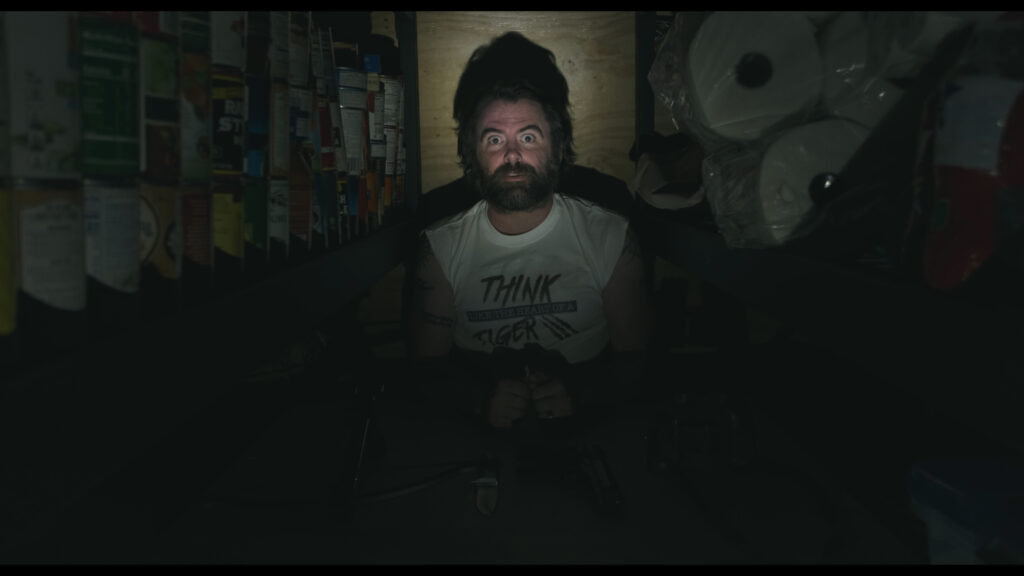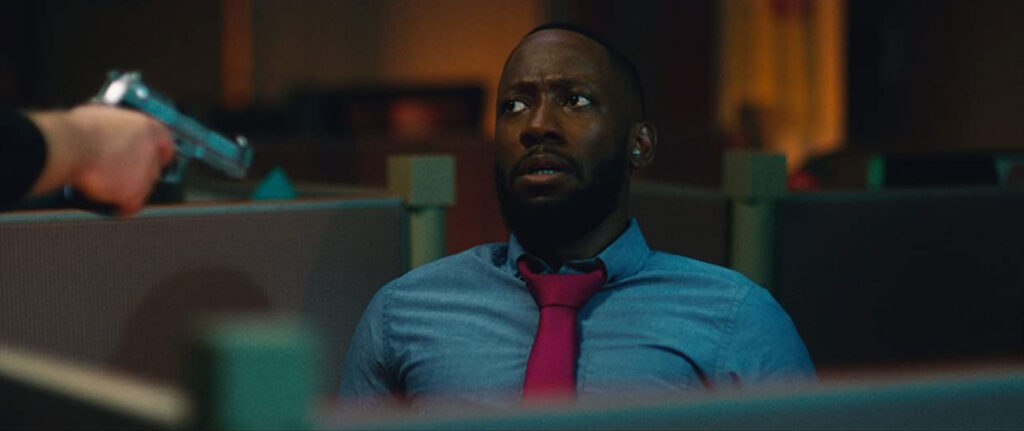December 22, 2022
by Carla Hay

“The Disappearance of Toby Blackwood”
Directed by Joe Ahern
Culture Representation: Taking place somewhere on the West Coast of the United States in 2020, the comedy film “The Disappearance of Toby Blackwood” features a predominantly white cast of characters (with a few African Americans and Latinos) representing the working-class and middle-class.
Culture Clash: During the COVID-19 pandemic lockdowns, a man decides to distract himself by searching for a former schoolmate who has become a semi-famous “doomsday” conspiracy theorist and who has disappeared during the pandemic.
Culture Audience: “The Disappearance of Toby Blackwood” will appeal primarily to people who don’t mind watching boring and idiotic comedies that use a deadly pandemic for cheap and unfunny jokes.

“The Disappearance of Toby Blackwood” is yet another unimaginative and repetitive movie with a COVID-19 theme. Viewers are stuck with the vapid and obnoxious characters, just like these characters are stuck quarantining and use it as an excuse to be stupid. This poorly made comedy is only 74 minutes long, but it feels like longer. There’s barely enough of a story to fill a short film, which is why it’s a chore to watch all of “The Disappearance of Toby Blackwood.”
“The Disappearance of Toby Blackwood” is an independently financed film that you can tell was made by frequently unemployed actors who decided to give themselves jobs by making a terrible movie. It explains why the director and co-writers of this dreadful dud have cast themselves as stars in the movie. “The Disappearance of Toby Blackwood” director Joe Ahern gets the most screen time as the film’s protagonist: a lackluster, middle-aged sad sack named Wes Crowley. Ahern co-wrote the movie’s atrocious screenplay with Doug Mellard, who plays the completely irritating Toby Blackwood.
Watching the misguided Ahern and Mellard as these two cretinous characters is like watching the polar opposite reasons why actors fail in their roles. Ahern is very listless and flat, while Mellard over-acts. “The Disappearance of Toby Blackwood” also commits one of the worst sins of a movie with a COVID-19 pandemic lockdown theme: It’s mostly a series of very insipid and increasingly annoying phone calls and videoconference chats.
The gist of this very limp story (which takes place somewhere on the West Coast of the U.S. in 2020) is that Wes is bored at home while quarantining during the COVID-19 pandemic lockdowns, so he and a few friends decide to find out what happened to Wes’ former schoolmate Toby, who has recently disappeared. Wes and Toby haven’t seen each other in about 20 years, but Wes knows that Toby has become a semi-famous “doomsday” conspiracy theorist. It’s mentioned early on in the film that Toby has 200,000 Twitter followers and 130,000 YouTube subscribers.
There’s a subplot about Wes being bitter because his wife Courtney (played by Natasha Hall) has left him and taken their dog Iggy Pup with her. Courtney also served divorce papers to Wes, in case it wasn’t clear that their marriage is over. Courtney left the dog bowl behind, and Wes whines in an early scene in the movie: “I don’t have the heart to throw it away, so I just stare at it all day.”
Throughout the movie, Wes does video chats with five of his closest friends: Luke Dalton (played by Grant Harvey), Carrie (played by Annie Karstens), Wendy (played by Ashley Spillers), Mike (played by Eddie Alfano) and Keith (played by Arjay Smith). Luke is the loudmouth jerk of the group, so you know he’s going to get the most screen time. Keith is the only one in this group who comes close to sounding like he’s the voice of reason, so course he gets the least screen time out of these five pals.
Luke is actually the one who comes up with the idea to look for Toby. Luke persuades a reluctant Wes to start an investigation, and eventually Wes becomes more interested in finding out what happened to Toby. It should be noted that Luke and Wes also drink a lot of beer during their investigation shenanigans, which might explain why their judgment is impaired but doesn’t explain why this movie is so horrendous.
“The Disappearance of Toby Blackwood” wastes a lot of time showing Luke and Wes talking to various people (usually Toby’s mentally ill followers), who have various theories about why Toby has gone missing. None of the theories is even remotely close to being amusing. “The Disappearance of Toby Blackwood” is filled with a lot of drab dialogue, such as this comment that Wes says that’s supposed to make viewers laugh: “Between my divorce, the quarantine and these bizarre conspiracy theories, I think I’ve aged 10 years in three days.”
A few fairly well-known actors make cameos as these weirdo followers of Toby. The cast members making quick appearances in this embarrassing movie include Simon Pegg, as a paranoid fan named Garth Arthur, who rambles on about alternate realities. Other actors portraying fans of Toby include Lamorne Morris as Gerald Meacham and Luis Guzmán as Chester Mendoza, who both have babbling, forgettable lines of dialogue. All it proves is that the filmmakers called in some favors to get these well-established actors to be in this awful movie.
Why hasn’t anyone contacted the police to report Toby missing? It’s explained early on in the movie that Wes and Luke don’t want to contact the police because Toby has enough guns (many probably illegal) to arm a militia, and they don’t want Toby to get in trouble with law enforcement. Why hasn’t anyone contacted Toby’s family members? Wes and Luke don’t want to alarm these relatives because Toby hasn’t officially been reported missing, and no one knows yet if Toby voluntarily disappeared, or if there was foul play involved.
“The Disappearance of Toby Blackwood” is just a tedious slog of these witless conversations. A low point is a segment showing terribly stereotypical depictions of Italian Americans: The brother characters of Vinny Balducci (played by Joseph Russo) and Paul Balducci (played by Jeremy Luke), who are in their 30s, talk about a grudge involving a murder and veal scallopini (don’t ask), as if they’re Super Mario Bros. wannabe mafia types. Other not-funny-at-all segments show a urine filtration device salesperson named Larry the Urine Guy (played by Rick Gomez) and an unhinged priest named Father Delgado (played by Rudy Mungaray).
A conspiracy fanatic named Mandy Prescott (played by Dana DeLorenzo), who says that she is Toby’s girlfriend, insists that Toby went to meet Microsoft co-founder Bill Gates at Area 51, because Toby thinks Gates created the COVID-19 pandemic so that Gates could put microchips in COVID vaccines. The movie also over-uses a so-called “joke” that some of Toby’s fans, including one named Gilbert Muldoon (played by Todd Giebenhain), think Area 51 is really located underneath the Denver International Airport. Don’t expect there to be any hidden cleverness to this “joke.” There is none.
Interspersed with these stale and vacuous conversations are scenes showing some of Toby’s conspiracy theory videos, so this movie’s viewers can see what type of garbage content he’s been spewing out into the world. There’s nothing original about what Toby says or does when he rants about government spying and “end of the world” predictions. “The Disappearance of Toby Blackwood” presents everything as a weak and uninteresting parody of real-life conspiracy theorists. All of the footage with Toby will just make viewers wish that Toby would stay permanently missing so that he stays far away from humanity. If you care about being entertained, you’re better off staying far away from “The Disappearance of Toby Blackwood.”
Freestyle Digital Media released “The Disappearance of Toby Blackwood” on digital and VOD on December 20, 2022.








